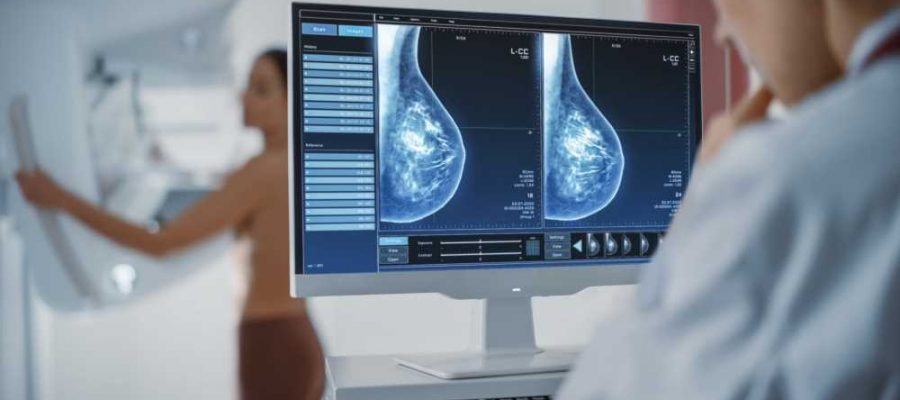In a recent review published in Current Oncology, researchers highlighted the technical and clinical considerations for proton radiotherapy delivery for individuals with locally advancing breast malignancies.

Background
The number of locally advanced breast tumor patients is increasing.The tumors are usually treated by a combination of surgery and radiotherapy. Conventional radiotherapy methods use X-rays that direct photons to the target site, such as intensity-modulated radiation therapy (IMRT) and image-guided and stereotactic RT. The techniques result in unintentional dose deposition to surrounding organs. In this scenario, proton therapy seems to be a better option since protons spare radiation delivery to vital organs due to the sharp fall-off of the radiation dose (the “Bragg peak” effect).
About the review
In the present review, researchers reviewed existing literature on proton radiotherapy for locally advancing breast cancers, highlighting its benefits and clinical and technical considerations.
Current challenges in radiotherapy
Conventional radiation treatment results in pulmonary and cardiac toxicities, enhancing the risk of cardiac death. Radiotherapy-associated major cardiovascular events include coronary revascularization, myocardial infarction, and ischemic heart disease-related death. Studies have reported a 7.40% linear elevation in the major cardiovascular events with every 1.0 Gray (Gy) elevation in the average cardiac dose. Low dosage to the cardiac left ventricle tissues is most strongly associated with cardiac adverse events after radiotherapy. Studies have indicated an average dose of 2.80 Gy to the left-side anterior descending (LAD) artery as a cutoff for radiotherapy-induced cardiotoxicity development.
Studies have reported a linear increase in secondary pulmonary tumor risks with every 8.50 Gy elevation in the radiation dosage, and that alternate therapeutic modality must be considered in cases of <30% of the ipsilateral pulmonary tissues receive 20.0 Gy radiation or in cases of <15.0 Gy average pulmonary dose. The increase in the secondary tumor risks associated with IMRT and volumetric arc therapy (VMAT) underscores the need to optimize the delivery of radiotherapy among locally advancing breast tumor patients.
Cardiopulmonary benefits, considerations, and ongoing trials of proton radiotherapy
Proton radiotherapy can address dosage inhomogeneity and reduce the radiation dose to the pulmonary and cardiac tissues. Studies have reported that, in comparison to photon radiotherapy, proton radiotherapy can lower the risks of tumor recurrence and acute coronary events by 0.90% and ≤2.9%, respectively. Consistent oncologic outcomes have been reported with photon radiotherapy, and notably, there were no cardiac alterations of concern using cardiac biomarkers or strain echocardiography up to 2.0 months post-therapy.
Cancer Research eBook

Studies have demonstrated the benefits of proton radiotherapy, utilizing pencil beam-type scanning, in optimizing pulmonary doses and thereby decreasing second primary pulmonary tumor and contralateral side breast tumor risks, compared to IMRT/VMAT approaches. Proton therapy is especially beneficial in complicated and locally advancing breast tumors requiring breast tissue reconstruction.
Delivery of radiotherapy involves challenges associated with prosthesis positioning and the associated increase in radiation exposure of the contralateral side breast, compounded in cases that require treating the regional nodes. Proton radiotherapy has reportedly improved the dosimetric parameters, with acceptable breast reconstruction outcomes, compared to photon radiotherapy.
The target tissue must be precisely delineated to protect other organs. For example, breast target volumes must not include the ribs or intercostal muscles posteriorly in cases of negative direct cancer extension for ensuring dosage fall-off anteriorly to the lungs and heart. The skin of the chest must be contoured separately, and doses should be carefully determined, given proton radiotherapy does not spare skin to avoid acute toxicities.
Before treatment, positron emission tomography (PET) imaging may be performed on the computed tomography (CT) scans to ensure precise target tissue coverage. The probable effects of intra-fraction and inter-fraction alterations associated with proton radiotherapy must be addressed. Techniques to mitigate the effects, like guided imagery, might be needed to improve outcomes.
The sparing of cardiac and other tissues with proton radiotherapy could be, in part, mitigated if the linear energy transfer (LET) values are not incorporated appropriately. Future studies are required to improve understanding of the relative biological effectiveness (RBE) of protons and to optimize therapeutic ratios for patients.
Ongoing trials conducted using proton radiotherapy for locally advancing breast cancers include the Danish breast cancer group phase 3.0 randomized clinical trial (DBCG), the United Kingdom (UK) ISRCTN14220944 clinical trial, and the randomized trial of proton versus photon therapy for patients with non-metastatic breast tumor (RADCOMP).
Conclusions
Based on the review findings, proton radiotherapy seems promising for improving target tissue coverage and reducing the dose to the organs at risk, reducing major coronary event risks among locally advancing breast tumor patients, compared to traditional radiotherapy. The review findings could guide clinician decision-making and inform healthcare professionals providing proton radiotherapy to individuals with locally advancing breast tumors.
Several randomized clinical trials on proton radiotherapy are ongoing; however, studies must be conducted to assess particular aspects of proton therapy delivery, including hypofractionation and particular patient profiles, such as individuals needing breast reconstruction. Further research could improve the selection of patients for radiotherapy using protons and appropriately harness the promising technology of protons to serve breast cancer patients better.
- Lalani, N.; Alqarni, S.; Jimenez, R.B. (2023). The Potential of Proton Therapy for Locally Advanced Breast Cancer: Clinical and Technical Considerations. Current Oncology. doi: https://doi.org/10.3390/curroncol30030219 https://www.mdpi.com/1718-7729/30/3/219
Posted in: Medical Science News | Medical Research News | Women's Health News | Disease/Infection News
Tags: Breast Cancer, Breast Reconstruction, Cancer, Clinical Trial, Computed Tomography, CT, Healthcare, Heart, Heart Disease, Imaging, Ischemic Heart Disease, Lungs, Myocardial Infarction, Oncology, Positron Emission Tomography, Proton Therapy, Radiation Exposure, Radiation Therapy, Radiotherapy, Research, Skin, Surgery, Technology, Tomography, Tumor

Written by
Pooja Toshniwal Paharia
Dr. based clinical-radiological diagnosis and management of oral lesions and conditions and associated maxillofacial disorders.
Source: Read Full Article
